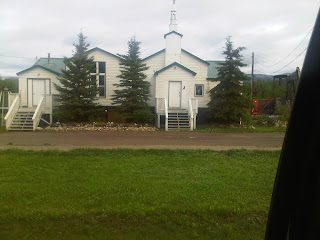Today we fly! It’s just a matter of when. The sky over the
Wells is clear, however there is a low cloud bank covering the mountains and as
we are flying VFR (visual flight rules) it is kinds nice to see what we are
flying into.
We headed out for Mile 50. Another beautiful place on the Little
Keele River.
The rapids.
Some massive bulldozer blades.
A caboose, these are the bunk houses that the workers slept in. they are mounted on huge wooden skids and were pulled from one work place to another.
On old Studebaker engine
Form there we moved on to Mile 108, up on the plateau near
Devil’s Pass. This was Pump station 4 of the pipeline. The weather was fine
when we landed, however by the time we were ready to leave we were in the
middle of a downpour. We got wet!
Up and over "The Pass"
The site sits in a beautiful valley.
The power building (in the foreground) and the Pumphouse (in the background).
Tea time with the Kelly Kettle at Mile 108.
Then moving up the trail to Mile 131, a small camp and 131.3 is the
location of one of the spill sites I visited on my last trip on the Canol. The
weather here cleared up for a few minutes, then we were hit by a micro-burst. We
got wetter, soaked through the rain suit to the skin.
A few shots of the Canol Trail.
Arriving at Mile 131/131.3. Mile 131 is the location of the camp, there are several cabooses, most of which are in very poor condition.
A view of the river bank and the incoming weather front.
And here comes the rain - again!
A quick stop at Ram’s Head for fuel for the chopper. While
there we met some hunters who were on their way home after a successful hunt.
The sky starting to clear, we are starting to dry.
We then finished the work day with a landing at Mile 202 to
ground proof what we had seen during our flyover from the other day. Still
drying out, with the windows open on the chopper it’s like being in a dryer.
Mile 202 is down there on the river bank.
Another old truck up on blocks.
This is one of the wooden skids that i had mentioned earlier.
The 1 ½ hour flight back to the Wells was a rough one as we
flew through one storm after another. By the time we landed we were completely
dried out, until we got out of the chopper to unload our samples and equipment,
another micro- burst, wet again.
Tomorrow we fly back to Yellowknife if we can get a flight
however there is still lots of packing and shipping of samples and equipment to
be done before we fly. It could be a late night and an early morning.
I wish to thank the ground crew and our pilot, Devin, at
Canadian Helicopters in Norman Wells for providing excellent service both in the
air and on the ground.
I would also like to thank our wildlife monitor, Cody, for
all the help and information he provided us.
Cheers.






























